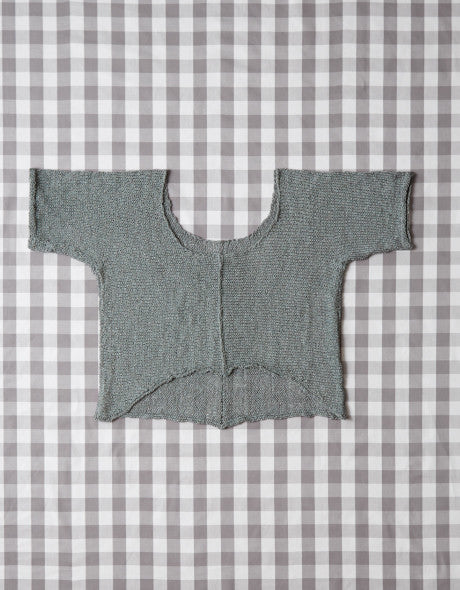
TO BLOCK OR NOT TO BLOCK, THAT IS THE QUESTION
(with apologies to Shakespeare)
Allow me to set the scene: a knitter triumphantly casts off the last stitch, puts the needles down and gleefully admires the glorious handknit before them. All the hours spent, all the stitches counted, all the tinking back and making sure every single bit of the project was right, and now the crafting is finished. It’s time to show off that new project to the world!
But put the brakes on for just a moment, and look at the pattern finishing instructions . Usually there’s a phrase there that many of us like to overlook in that victory lap of finishing a long-time WIP: “block item to schematic measurements”, “block aggressively”, block, block, block…
OK, we get the picture: we’re supposed to block our new FO. But what exactly does that mean and how do you do it?
Simply put, blocking is the process that allows your knitted and crocheted stitches to finish settling in to their proper places. It evens out wonky stitches, and makes textures pop and lace sing. Blocking is the ultimate finishing touch for making your knit and crochet pieces look their best.

Blocking is also critically important for lace and stranded knitting, as it makes the lace open up and evens out uneven tension and floats in colourwork. It’s also just a good idea to block to get rid of any muck that might have gotten into your project as you’ve been working on it – think of it as a final primping before the big debut!
How you block will vary depending on the item and the fibre content of the yarn. I usually wet block everything; I soak the item in cool-to-lukewarm water with some wool wash (Soak is my favourite for many reasons but a big one is that no rinsing is required!) for at least 15-20 min. Longer is ok too - more often then not I forget its in the sink and come back to it several hours later…

The next step is to squeeze out as much water as you can. In my blocking, this usually means putting it in a lingerie bag and running it through the spin cycle on my washing machine, which gets rid of almost all excess water. If you’re nervous about doing that, you can wrap the item in several towels and stand on the roll to squeeze out as much water as possible. It’s very important to avoid moving your project around too much – don’t wring it out! – because this can cause felting if you’re working with wool.
When you’ve gotten rid of as the excess water, the next step is to lay out the piece and leave it to dry. For things like jumpers, socks and most other accessories, I like to spread the item out and pat it into shape, making sure it’s as symmetrical as possible. For jumpers, I will measure at critical fit points – bust, hem, sleeve – and check against the pattern schematic to make sure its going to be the size I want it to be when it’s dry! The Gauge Cloth from Cocoknits makes this dead easy as it's a 1" square grid you can lay your garment on. I sometimes use pins and blocking wires (if needed) to help get the right measurements.

Blocking wires and pins become very important if you are knitting lace and want it to look its best. As anyone who’s ever knit a lace shawl can attest, unblocked lace looks like a pile of overcooked spaghetti. However, after a soak and a good strong block, the yarn overs of the lace open up and the inherent dynamic structure is revealed. Lace should always be blocked, and stretched out farther then you’d think is possible, to show off all that hard work you’ve put into it.
To block a lace shawl, blocking wires are a great investment: these are semi-flexible wires that can be threaded through the edges of your lace and pinned out, thereby removing the need to use forty million pins on each point of your edging, and making it easier to block evenly.
You can thread the blocking wires through your piece before you soak it or afterwards, but it’s usually easier to do when the item is dry. Just make sure you can still get the whole piece wet with the wires already in place! Use the same procedure for soaking and getting rid of the excess water, and then find a good big space and stretch that lace out.

Some types of fabric don’t benefit from wet blocking. If you’ve got a fabric that is very highly textured, you may want to steam the piece instead of wet blocking and risking losing some of that texture. To do this, use a steamer or iron with a steam setting, lay the piece out and let the steam penetrate the fabric. Move back and forth until the entire work has been exposed to the steam and then let it dry.
Wool blocks beautifully and will hold its blocked shape well (at least until it gets wet again). Wool blends will also block well, whether the wool is blended with silk, plant fibres or a small proportion of synthetics. Cotton should be blocked, not necessarily to get the correct shape or measurements (cotton has very little memory), but to even out any uneven tension in the piece. However, things made out of 100% acrylic will certainly benefit from a wash, but they can’t be blocked out and stretched the way wool fibres can.
In the end, the choice of whether to block or not is entirely up to you, but if you want your finished objects to really shine give them a bit of extra TLC with a bath and a bit of a primp, and you'll be amazed by the results!
-Rachel of PorpoiseFur

Judy K Poll on
I totally disagree with “things made out of 100% acrylic will certainly benefit from a wash, but they can’t be blocked out.” I lightly steam block acrylics all the time to give it a nice drape. Once blocked, it holds it’s shape very well.
Susan Torr on
I’ve just finished a double knitting pure wool baby blanket 36″ × 36″. It’s mainly stocking stitch with some pattern and borders in moss stitch. Should I wet block or steam block – it’s looking quite creased and uneven at the moment. Thanks.
Teresa on
I just completed a linen stitch cowl. Should I block it? I used Malibrigo yarn, size 6 and 10 needles. Thanks for any insight you have.